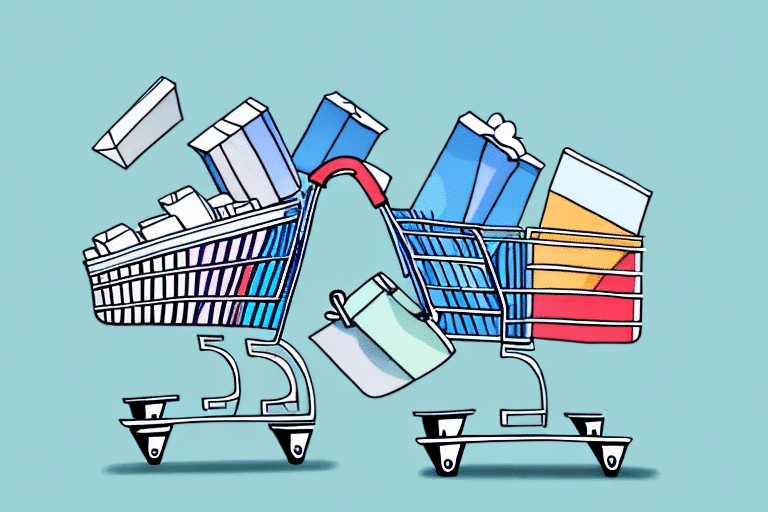What Is Cart Abandonment? Understanding the Causes and Solutions
As online shopping continues to replace traditional brick-and-mortar retail, businesses are increasingly facing the challenge of cart abandonment. Cart abandonment refers to the frustrating phenomenon of customers leaving items in their virtual shopping carts without completing the purchase. This phenomenon costs e-commerce businesses around the world a considerable amount of money—estimated at over $1 trillion annually. It is crucial for businesses to understand the causes of cart abandonment and develop effective strategies to minimize it.
The Impact of Cart Abandonment on E-commerce Business
The impact of cart abandonment on e-commerce businesses cannot be overstated. It is a significant contributor to the loss of revenue for businesses that rely on online sales. According to recent statistics by BarcodesInc, the average cart abandonment rate is around 70 percent globally, meaning that only 30 percent of shoppers who add an item to their cart go on to make a purchase. The consequences of this trend are clear—lost sales, diminished revenue, and lower profits for businesses.
One of the main reasons for cart abandonment is unexpected costs such as shipping fees, taxes, and other hidden charges. Customers may feel misled or deceived when they see additional costs at checkout, leading them to abandon their cart and look for a better deal elsewhere. To combat this issue, businesses can be transparent about all costs upfront and offer free shipping or discounts for larger purchases.
Another factor that contributes to cart abandonment is a complicated checkout process. Customers may become frustrated with lengthy forms, multiple steps, and slow loading times, leading them to abandon their cart and seek a simpler option. To address this issue, businesses can streamline their checkout process by reducing the number of steps, simplifying forms, and optimizing their website for faster loading times.
Common Reasons Why Customers Abandon Carts
Understanding the reasons behind cart abandonment is essential in designing effective solutions for this problem. Studies conducted on e-commerce consumer behavior identify several common reasons why customers abandon their carts:
- Unexpected costs and fees: When customers encounter hidden charges, such as high shipping fees, at the end of their transaction, they may abandon their cart.
- Lack of trust and security: Online shoppers may hesitate to provide sensitive personal information or credit card details without reassurances about data protection and privacy.
- Complicated checkout processes: If shoppers have a hard time navigating through checkout processes with too many pages, unclear instructions, or improper formatting, they may give up and abandon their carts.
- Lack of product information: When customers are not provided with enough information about the product, including images, descriptions, and specifications, they may be hesitant to make a purchase.
Additionally, limited payment options and the absence of a guest checkout option can also lead to cart abandonment. Customers often prefer using specific payment methods like PayPal or Apple Pay, and if these are not available, they may abandon their carts. Similarly, requiring customers to create an account before purchasing can deter them from completing the transaction.
Strategies to Reduce Cart Abandonment
Optimize the Checkout Process
Simplifying the checkout process is one of the most effective ways to reduce cart abandonment. This can be achieved by:
- Minimizing the number of pages or steps required for checkout.
- Allowing customers to check out as guests or via social media accounts for a faster and more seamless experience.
- Providing a progress indicator so customers can see how many steps are left.
- Ensuring the checkout process is optimized for both desktop and mobile devices.
Transparent Pricing
Eliminate unexpected costs by being transparent about all pricing upfront. Clearly display shipping fees, taxes, and any additional charges before customers reach the checkout page. Offering free shipping for orders above a certain value can also incentivize customers to complete their purchases.
Enhance Trust and Security
Building trust with customers is crucial. Display trusted security badges, use SSL certificates to encrypt data, and provide clear privacy policies. Ensuring that your website looks professional and trustworthy can alleviate customer concerns about data security.
Provide Multiple Payment Options
Offering a variety of payment methods can cater to different customer preferences. Popular options include credit/debit cards, PayPal, Apple Pay, and Google Wallet. The more choices you provide, the higher the likelihood of completing a sale.
Implement Cart Recovery Strategies
Cart recovery strategies are essential for capturing lost sales. Effective methods include:
- Abandoned Cart Emails: Send personalized emails to remind customers of their abandoned carts, possibly including discounts or incentives to encourage completion of the purchase.
- Retargeting Ads: Use retargeting ads on platforms like Facebook and Google to remind customers of the items they left behind.
- Exit-Intent Popups: Trigger popups when a customer is about to leave the site, offering discounts or assistance to complete the purchase.
Best Practices for Optimizing Checkout for Higher Conversion Rates
Optimizing the checkout process can significantly improve conversion rates. Here are some best practices:
- Minimize Distractions: Keep the checkout page free from unnecessary elements that could distract customers from completing their purchase.
- Auto-Fill and Validation: Use auto-fill features and real-time form validation to make the process quicker and reduce errors.
- Clear Call-to-Action: Use prominent and clear call-to-action buttons like "Complete Purchase" to guide customers through the process.
- Mobile Optimization: Ensure that the checkout process is fully functional and user-friendly on mobile devices.
Leveraging Personalized Recommendations to Reduce Cart Abandonment
Personalized recommendations can enhance the shopping experience and reduce cart abandonment rates. By analyzing customer behavior and preferences, you can suggest related products that may interest them. Additionally, personalized emails with similar product recommendations or exclusive discounts can entice customers to return and complete their purchases.
Effective Email Marketing Campaigns for Recovering Abandoned Carts
Email marketing remains one of the most effective tools for recovering abandoned carts. Successful campaigns typically include:
- Timing: Send the first reminder within an hour of abandonment, followed by additional reminders over the next few days.
- Personalization: Address customers by name and reference the specific items left in the cart.
- Incentives: Offer discounts, free shipping, or other incentives to encourage completion of the purchase.
- Clear Call-to-Action: Include prominent buttons or links that take customers directly back to their abandoned carts.
Retargeting Ads: Winning Back Lost Customers
Retargeting ads are a powerful way to re-engage customers who have abandoned their carts. By displaying personalized ads on social media platforms like Facebook, Instagram, and LinkedIn, as well as on search engines, businesses can remind customers of the items they left behind and encourage them to return and complete their purchases.
According to a study by WordStream, retargeting ads can increase conversion rates by up to 150%, making them a highly effective tool for cart recovery.
Measuring the Success of Your Cart Recovery Efforts
To optimize your cart recovery strategies, it's essential to measure their effectiveness using key performance indicators (KPIs). Important KPIs include:
- Cart Abandonment Rate: The percentage of shoppers who abandon their carts before completing a purchase.
- Conversion Rate: The percentage of abandoned carts that are successfully recovered.
- Revenue Recovered: The total amount of revenue generated from recovered carts.
- Return on Investment (ROI): The profitability of your cart recovery efforts compared to the costs involved.
Using tools like Google Analytics and e-commerce platforms' built-in analytics, businesses can track these metrics and make data-driven decisions to enhance their cart recovery strategies continuously.
Future Trends in Cart Abandonment and E-commerce Optimization
The future of cart abandonment and e-commerce optimization is moving towards more personalized and automated strategies. Key trends include:
- Artificial Intelligence and Machine Learning: Leveraging AI to predict cart abandonment and offer real-time personalized incentives.
- Predictive Analytics: Using data to anticipate customer behavior and proactively address potential abandonment triggers.
- Automation and Chatbots: Implementing chatbots to assist customers during the checkout process, answer queries, and provide support.
- Mobile Optimization: Focusing on enhancing the mobile shopping experience as a significant portion of e-commerce traffic comes from mobile devices.
- Social Media Integration: Utilizing social media platforms for seamless shopping experiences and retargeting efforts.
By staying ahead of these trends, e-commerce businesses can create a more seamless and engaging shopping experience, ultimately reducing cart abandonment and increasing sales.
Conclusion
Cart abandonment is a significant challenge that e-commerce businesses face. Understanding the causes and implementing effective solutions can help minimize it, recover lost sales, and increase revenue. By optimizing the checkout process, providing transparent information, and using personalized recommendations and retargeting ads, businesses can improve their chances of converting customers to complete a purchase. Measuring the success of cart recovery efforts and staying up to date on future trends can help businesses continue to achieve success in the ever-changing world of e-commerce.




















